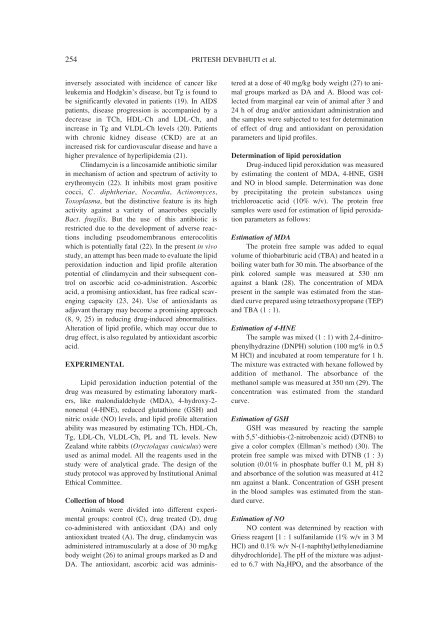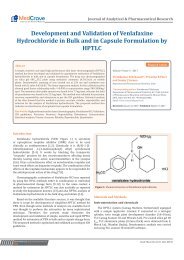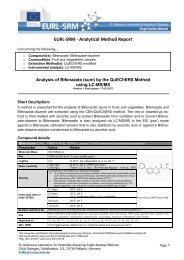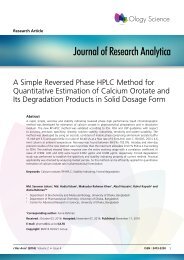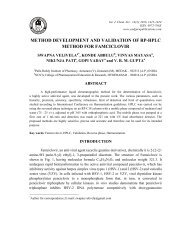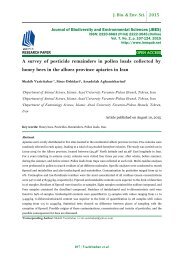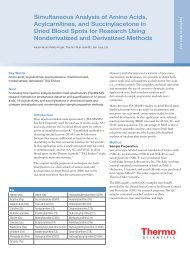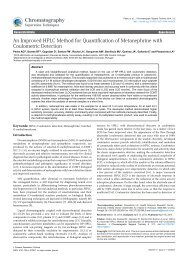acta 2_2015
acta 2_2015
acta 2_2015
- No tags were found...
Create successful ePaper yourself
Turn your PDF publications into a flip-book with our unique Google optimized e-Paper software.
254 PRITESH DEVBHUTI et al.inversely associated with incidence of cancer likeleukemia and Hodgkinís disease, but Tg is found tobe significantly elevated in patients (19). In AIDSpatients, disease progression is accompanied by adecrease in TCh, HDL-Ch and LDL-Ch, andincrease in Tg and VLDL-Ch levels (20). Patientswith chronic kidney disease (CKD) are at anincreased risk for cardiovascular disease and have ahigher prevalence of hyperlipidemia (21).Clindamycin is a lincosamide antibiotic similarin mechanism of action and spectrum of activity toerythromycin (22). It inhibits most gram positivecocci, C. diphtheriae, Nocardia, Actinomyces,Toxoplasma, but the distinctive feature is its highactivity against a variety of anaerobes speciallyBact. fragilis. But the use of this antibiotic isrestricted due to the development of adverse reactionsincluding pseudomembranous enterocolitiswhich is potentially fatal (22). In the present in vivostudy, an attempt has been made to evaluate the lipidperoxidation induction and lipid profile alterationpotential of clindamycin and their subsequent controlon ascorbic acid co-administration. Ascorbicacid, a promising antioxidant, has free radical scavengingcapacity (23, 24). Use of antioxidants asadjuvant therapy may become a promising approach(8, 9, 25) in reducing drug-induced abnormalities.Alteration of lipid profile, which may occur due todrug effect, is also regulated by antioxidant ascorbicacid.EXPERIMENTALLipid peroxidation induction potential of thedrug was measured by estimating laboratory markers,like malondialdehyde (MDA), 4-hydroxy-2-nonenal (4-HNE), reduced glutathione (GSH) andnitric oxide (NO) levels, and lipid profile alterationability was measured by estimating TCh, HDL-Ch,Tg, LDL-Ch, VLDL-Ch, PL and TL levels. NewZealand white rabbits (Oryctolagus cuniculus) wereused as animal model. All the reagents used in thestudy were of analytical grade. The design of thestudy protocol was approved by Institutional AnimalEthical Committee.Collection of bloodAnimals were divided into different experimentalgroups: control (C), drug treated (D), drugco-administered with antioxidant (DA) and onlyantioxidant treated (A). The drug, clindamycin wasadministered intramuscularly at a dose of 30 mg/kgbody weight (26) to animal groups marked as D andDA. The antioxidant, ascorbic acid was administeredat a dose of 40 mg/kg body weight (27) to animalgroups marked as DA and A. Blood was collectedfrom marginal ear vein of animal after 3 and24 h of drug and/or antioxidant administration andthe samples were subjected to test for determinationof effect of drug and antioxidant on peroxidationparameters and lipid profiles.Determination of lipid peroxidationDrug-induced lipid peroxidation was measuredby estimating the content of MDA, 4-HNE, GSHand NO in blood sample. Determination was doneby precipitating the protein substances usingtrichloroacetic acid (10% w/v). The protein freesamples were used for estimation of lipid peroxidationparameters as follows:Estimation of MDAThe protein free sample was added to equalvolume of thiobarbituric acid (TBA) and heated in aboiling water bath for 30 min. The absorbance of thepink colored sample was measured at 530 nmagainst a blank (28). The concentration of MDApresent in the sample was estimated from the standardcurve prepared using tetraethoxypropane (TEP)and TBA (1 : 1).Estimation of 4-HNEThe sample was mixed (1 : 1) with 2,4-dinitrophenylhydrazine(DNPH) solution (100 mg% in 0.5M HCl) and incubated at room temperature for 1 h.The mixture was extracted with hexane followed byaddition of methanol. The absorbance of themethanol sample was measured at 350 nm (29). Theconcentration was estimated from the standardcurve.Estimation of GSHGSH was measured by reacting the samplewith 5,5í-dithiobis-(2-nitrobenzoic acid) (DTNB) togive a color complex (Ellmanís method) (30). Theprotein free sample was mixed with DTNB (1 : 3)solution (0.01% in phosphate buffer 0.1 M, pH 8)and absorbance of the solution was measured at 412nm against a blank. Concentration of GSH presentin the blood samples was estimated from the standardcurve.Estimation of NONO content was determined by reaction withGriess reagent [1 : 1 sulfanilamide (1% w/v in 3 MHCl) and 0.1% w/v N-(1-naphthyl)ethylenediaminedihydrochloride]. The pH of the mixture was adjustedto 6.7 with Na 2 HPO 4 and the absorbance of the


